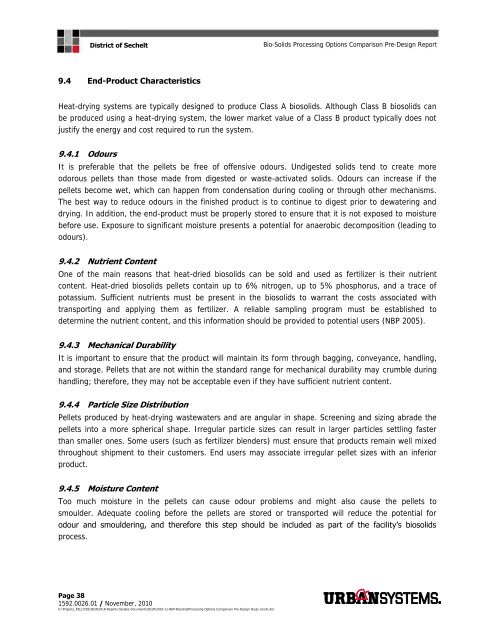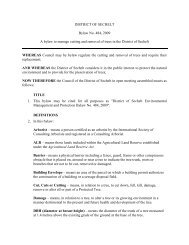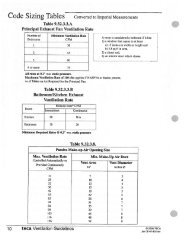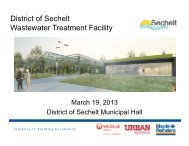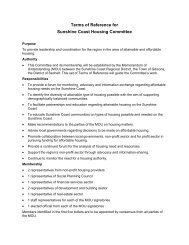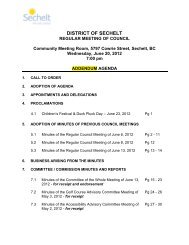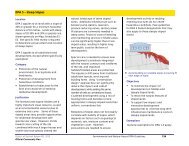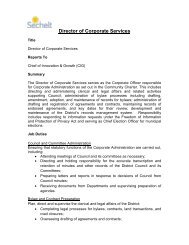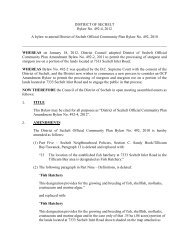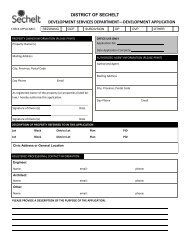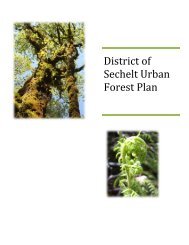District of Sechelt Preliminary Report
District of Sechelt Preliminary Report
District of Sechelt Preliminary Report
Create successful ePaper yourself
Turn your PDF publications into a flip-book with our unique Google optimized e-Paper software.
<strong>District</strong> <strong>of</strong> <strong>Sechelt</strong><br />
Bio-Solids Processing Options Comparison Pre-Design <strong>Report</strong><br />
9.4 End-Product Characteristics<br />
Heat-drying systems are typically designed to produce Class A biosolids. Although Class B biosolids can<br />
be produced using a heat-drying system, the lower market value <strong>of</strong> a Class B product typically does not<br />
justify the energy and cost required to run the system.<br />
9.4.1 Odours<br />
It is preferable that the pellets be free <strong>of</strong> <strong>of</strong>fensive odours. Undigested solids tend to create more<br />
odorous pellets than those made from digested or waste-activated solids. Odours can increase if the<br />
pellets become wet, which can happen from condensation during cooling or through other mechanisms.<br />
The best way to reduce odours in the finished product is to continue to digest prior to dewatering and<br />
drying. In addition, the end-product must be properly stored to ensure that it is not exposed to moisture<br />
before use. Exposure to significant moisture presents a potential for anaerobic decomposition (leading to<br />
odours).<br />
9.4.2 Nutrient Content<br />
One <strong>of</strong> the main reasons that heat-dried biosolids can be sold and used as fertilizer is their nutrient<br />
content. Heat-dried biosolids pellets contain up to 6% nitrogen, up to 5% phosphorus, and a trace <strong>of</strong><br />
potassium. Sufficient nutrients must be present in the biosolids to warrant the costs associated with<br />
transporting and applying them as fertilizer. A reliable sampling program must be established to<br />
determine the nutrient content, and this information should be provided to potential users (NBP 2005).<br />
9.4.3 Mechanical Durability<br />
It is important to ensure that the product will maintain its form through bagging, conveyance, handling,<br />
and storage. Pellets that are not within the standard range for mechanical durability may crumble during<br />
handling; therefore, they may not be acceptable even if they have sufficient nutrient content.<br />
9.4.4 Particle Size Distribution<br />
Pellets produced by heat-drying wastewaters and are angular in shape. Screening and sizing abrade the<br />
pellets into a more spherical shape. Irregular particle sizes can result in larger particles settling faster<br />
than smaller ones. Some users (such as fertilizer blenders) must ensure that products remain well mixed<br />
throughout shipment to their customers. End users may associate irregular pellet sizes with an inferior<br />
product.<br />
9.4.5 Moisture Content<br />
Too much moisture in the pellets can cause odour problems and might also cause the pellets to<br />
smoulder. Adequate cooling before the pellets are stored or transported will reduce the potential for<br />
odour and smouldering, and therefore this step should be included as part <strong>of</strong> the facility’s biosolids<br />
process.<br />
Page 38<br />
1592.0026.01 / November, 2010<br />
U:\Projects_KEL\1592\0026\01\R-<strong>Report</strong>s-Studies-Documents\Draft\2010-11-REP-BiosolidsProcessing Options Comparison Pre-Design Study (rev3).doc


